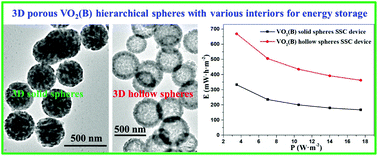Controlled synthesis of 3D porous VO2(B) hierarchical spheres with different interiors for energy storage†
Abstract
A strategy for the synthesis of three-dimensional (3D) porous VO2(B) hierarchical spheres with different interiors (solid spheres and hollow spheres) was developed by a template-free method. 3D VO2(B) solid spheres were synthesized by the precipitation of precursor spheres at room temperature and subsequent calcination, while 3D VO2(B) hollow spheres were prepared by the hydrothermal treatment of precursor spheres and subsequent calcination. BET specific surface areas of VO2(B) solid spheres and hollow spheres were measured to be 18 and 29 m2 g−1, respectively, and their porosity varied from mesoporous to macroporous with hierarchical structures. Electrochemical properties of 3D porous VO2(B) hierarchical spheres were studied by cyclic voltammetry (CV), galvanostatic charge–discharge (GCD) and electrochemical impedance spectroscopy (EIS). As electrode materials, the specific capacitances of 3D VO2(B) hollow spheres and solid spheres reach as high as 1175 mF cm−2 (336 F g−1) and 951 mF cm−2 (272 F g−1) at 2 mA cm−2, respectively. After 10 000 cycles, the capacitance retention of about 68% and 49% was observed for VO2(B) hollow spheres and solid spheres, respectively. Furthermore, symmetric supercapacitor (SSC) devices using VO2(B) hollow spheres and VO2(B) solid spheres were assembled, and they exhibited good pseudocapacitive properties. VO2(B) hollow sphere-SSC device delivered an areal capacitance of 246 mF cm−2 at 1 mA cm−2, while VO2(B) solid sphere-SSC device delivered an areal capacitance of 122 mF cm−2 at 1 mA cm−2. VO2(B) hollow spheres exhibit better electrochemical properties, including specific capacitance, areal energy density and cycling stability, compared with those of VO2(B) solid spheres. The findings in this work demonstrate that 3D porous VO2(B) hierarchical spheres with different interiors can improve the electrochemical properties of VO2(B) and can be considered promising candidates for high-performance energy storage materials.



 Please wait while we load your content...
Please wait while we load your content...